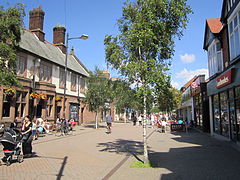Great Crosby
| Great Crosby | |
|---|---|
 Moor Lane, Great Crosby |
|
| Great Crosby shown within Merseyside | |
| OS grid reference | SJ326989 |
| Metropolitan borough | |
| Metropolitan county | |
| Region | |
| Country | England |
| Sovereign state | United Kingdom |
| Post town | LIVERPOOL |
| Postcode district | L23 |
| Dialling code | 0151 |
| Police | Merseyside |
| Fire | Merseyside |
| Ambulance | North West |
| EU Parliament | North West England |
| UK Parliament | |
Great Crosby is an area of the town of Crosby, in the Metropolitan Borough of Sefton, Merseyside, England and is historically, part of Lancashire.
In 1907, the Victoria County History described Great Crosby's location thus: 'The ancient township of Great Crosby, which includes Waterloo, lies on the northern shore of the estuary of the Mersey, with a level sandy beach extending over three miles (5 km) from north-west to southeast; it stretches inland some two miles (3 km), and has an area of 2,168 acres (8.77 km2), of which 1,907 acres (7.72 km2) belong to the present diminished township. The village, which lies more than a mile inland, is becoming modernized and growing quickly, especially along the principal road, that from Liverpool to Southport, which crosses the township in a northerly direction, with roads branching off to the shore and to Thornton. The Liverpool and Southport line of the Lancashire and Yorkshire Railway, opened in 1848, with stations at Waterloo and Blundellsands, also passes through the township. An electric tramway connects Great Crosby with the Seaforth terminus of the Liverpool Overhead Railway.'
Great Crosby was a small village of Viking origin until the arrival of the railway in the 1840s. The village grew rapidly during the late 19th and early 20th century and merged with a number of distinct areas with their own character, to form the Great Crosby urban district. These areas included:
The Great Crosby urban district annexed Little Crosby in 1932. In 1937, the district was combined with the Waterloo with Seaforth urban district to form the municipal borough of Crosby which was, in turn, absorbed into the new Metropolitan Borough of Sefton on 1 April 1974. These boundary changes defined the town of Crosby in its modern borders and shrank down the modern area of Great Crosby from the old urban district, making it an area of the modern town of Crosby which today is a separate area of Crosby to Blundellsands, Brighton-le-Sands, and Thornton.
...
Wikipedia

